Most current day traders, including myself, were not even born when the stock market crash of 1929 unfolded.
The 1929 crash was part of the biggest bear market the world has ever seen, losing 89% of its value and lasting from 1929 to1932, and was largely responsible for the Great Depression.
So is there something to learn from this stock market crash?
Learning from stock market history is the greatest place to understand how a market moves, but is the stock market crash of 1929 still relevant to today’s market environment….And if so how?

In this article I’d like to give a brief history of what lend up to the 1929 stock market crash, and highlight what I think are key learning points.
1929 Stock Market Crash History
The Roaring 20’s
During the 1920’s, or the Roaring 20’s, it was a time of great wealth and excess, where companies were prosperous and making very good profits.
At the same time that companies were flourishing, so was the stock market, with people and investment trusts being eager to invest in companies on the stock exchange, with little or no caution (lack of fear), because of such strong economic fundamentals. With investors making good profits from capital growth and dividends, by the late 20’s, investors just wanted as a slice of the action, probably though fear of missing out or greed. Often choosing to speculate with up to 90% Margin on preferred stock positions (as margin wasn’t controlled by government back then).
Speculative Investing with Margin and the Bubble
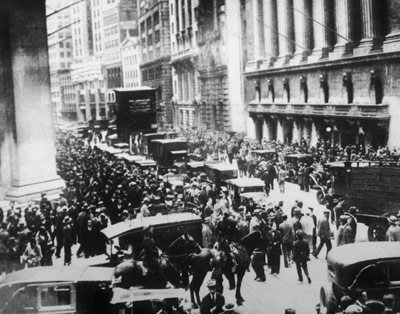
All this bullish buying by individual investors and investment trusts on margin, particularly in the utilities holding sector, caused a price expansion bubble in the US Stock Market.
To put this in perspective the market increased in value by 120% from 1925 to 1929, which was probably justifiable due to the strong economic conditions.
Between 1928-29, the economic conditions began to cool off, but Wall St seemed to disconnected from the reality and continued to rise with the already built in market momentum. Through this time a few leading expert economist were saying the market was overbought, and were calling for tighter control over margin investing. They believed that investor and trust speculation with margin was driving the market to an unprecedented level, and would be a real problem should the market run out of steam.
Negative Press
Prior to the 1929 crash the Dow Jones Industrial average had reached a high of 381.2 on September 3rd, 1929. But the financial press were beginning to focus heavily on the excessive margin activity and broker loans, and for the first time creating negative press about the market, particularly after the October 3rd correction.
Leading newspapers were claiming “Wall St. In Panic as Stocks Crash”, little did they know what was still to unfold.
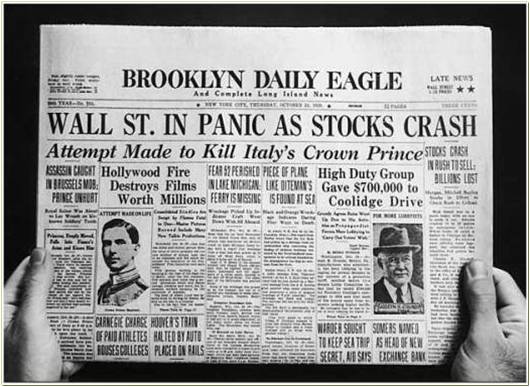
My guess is that despite the strong economics, with the negative press from the newspapers and some government officials, that for the first time that century, the smart money in the market started re-evaluating the economic fundamentals, and market sentiment started to shift.
Extreme Panic Selling accelerated by Margin Calls
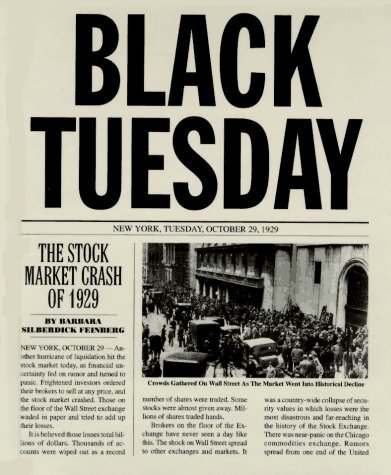
With margin lending so high, when selling started to increase, so did the Margin Calls, forcing investors to either come up with the extra cash, or sell their stocks to cover their obligation for the margin loan. This started an avalanche of selling, especially with the shifting market sentiment, where investors just wanted out.
Often stock market crashes are remembered for one or more days of extreme panic selling, and in the case of the 1929 stock market crash, it was the 24th and 29th of October 1929, which were later dubbed “Black Thursday” & “Black Tuesday“, suffering a 9% and 12% sell-off respectively.
The Great Depression
In all the market shed over 49% of its total value from September 3rd through to November 13th 1929, a total of 71 days of extreme selling. Although the market had a bear market rally for a few months after November, regaining 60% of the total fall. The macro market trend was still dominant, and the bear market resumed in April of 1930, which threw the Western World into the Great Depression, sparking chronic unemployment, severe hardship, and a banking crisis, with banks no longer willing to make credit available.
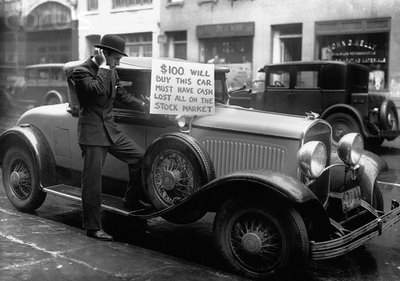
So let’s look at the facts that have been well documented about the 1929 crash, the 1929 Bear Market and the following Great Depression.
Stock Market Crash of 1929 Facts:
- 1925 – 1929 – The market value increase by 121%.
- Banks were heavily invested in stocks, and individual investors borrowed on margin to invest in stocks.
- 8th of August 1929 – Federal Reserve raised the cash interest rate to 6%.
- 3rd of October 1929 – Expert Market analyst Philip Snowden said the US market had developed into a ‘speculative orgy’.
- 4th of October 1929 – New York Times and Wall St Journal published articles agreeing with Snowden.
- 28th of October 1929 – Market gaps down and closes 13.5% down for the day.
- 29th of October 1929 – Market gaps down, and continues to sell-off massively, only to rally late in the day, but still closing 11.7% down for the day.
- 6th of November 1929 – Market gaps down, and closing 9.9% down for the day.
- September 1929 – November 1929 – Panic Selling on Wall St, with a 49% sell-off. Dow falls from 381 to 198.
- November 1929 – April 1930 – Market makes a 5 month recovery, with a 49% Bear Market Rally. Dow rises from 198 to 294
- April 1930 – July 1932 – The biggest Bear Market in history resumes with the Dow falling 86%. Dow falls from 294 to 41
- September 1929 – July 1932 – End of the 1929-32 Stock Market Crash, lasting 2 years and 305 days, with Wall Street loosing 89% of its total value.
- During the stock market crash of 1929, a total of $14 Billion dollars of wealth was lost.
- 23rd of November 1954 – The day the Dow Jones Industrial average finally recovered back to its Sept 1929 high.
Causes of the Stock Market Crash of 1929
- Overbought Stocks – A combination of strong economic fundamentals, very bullish market sentiment and the fact that many investors and investment trusts were able to buy stock with a high level of margin created a price expansion bubble, causing the market to become very overbought.
- Participants in the Market were Highly Leveraged – With a very low margin requirement from margin lenders, it was possible for investors to borrow up to 90% of the capital to buy preferred stock. This caused a lot of participants to be highly leveraged and susceptible to margin calls during market swings, forcing them to come up with extra cash to maintain the margin requirement, or be forced to sell stock when they least want to.
- Interest Rate increase – Federal Reserve increased the cash interest rate to 6%
- Poor Banking Regulations – The start-up capital regulations on new banks in the 1920’s was very poor. Hence many banks were insolvent after investing heavily in the stock market themselves and providing high leverage margin to market participants. After the 1929 Stock Market Crash, 40% of all US banks were no longer in business.
Key Learning Points of the 1929 Stock Market Crash
High Leverage Stock Portfolios
Leverage is a double edged sword. Being highly leveraged in the markets can amplify any swing the stock market can make, and adversely affect your stock portfolio.
It is also worth noting that some investment strategies securities have leverage built into them, like margin, leveraged ETF’s, stock options, and stocks in high leveraged companies. So it’s paramount to be aware of how leveraged your portfolio is.
While the attraction of big wins with higher leverage is attractive, it is always better to invest for the long term and manage your portfolio risk. So the lesson is, don’t take on to much leverage unless your portfolio is structured to handle it.
It is also a good idea to keep a percentage of your trading capital in cash, and in the event your portfolio takes an unexpected hit, you can still trade another day when the market calms, to take advantage of heavily discounted stocks.
The Power of Market Sentiment & Human Behavior
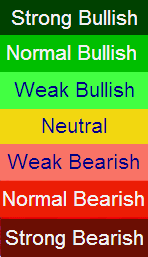 The study of human behavior in the stock market, is the study of stock market sentiment, and is quite different from analyzing the economic soundness, or fundamentals of the market. Market Sentiment is a general market view-point, either Bullish, Bearish or Neutral, based on the relationship between the fundamental and technical factors, and the current price.
The study of human behavior in the stock market, is the study of stock market sentiment, and is quite different from analyzing the economic soundness, or fundamentals of the market. Market Sentiment is a general market view-point, either Bullish, Bearish or Neutral, based on the relationship between the fundamental and technical factors, and the current price.
Stock Market Sentiment is what drives the market, and it is just as relevant in the stock market crash of 1929 as it is in today’s market, where sometimes there is a disconnect between market sentiment and the real world economic fundamentals, creating price expansion bubbles which are often followed by extreme selling at some point.
In stock market history there are many examples, both in the overall market and individual stocks, where the price can keep going up despite weakening fundamentals, and sometimes the price can crash despite relatively sound fundamentals. This is always driven by two key emotions in the market, Fear and Greed.
Market sentiment can be quickly shifted by media driven news, whether it be world events, or economic news. It’s worth noting that a series of presumably undramatic news events may also be enough to shift market sentiment, causing market-wide price decline.
To get a better picture of where the market is heading next, I recommend learning how to study and understand the overall Market Sentiment, and how investors behave during times of extreme greed and fear.
Market Timing
 Stock Market Timing will certainly make a difference to the success of building your portfolio wealth, by knowing the best times to enter and exit, what sector to enter, and when to stand aside. Many investors blindly invest in the market with little regard to what the trends are in the market, both short term and long term, & often don’t have plan of when they will get out.
Stock Market Timing will certainly make a difference to the success of building your portfolio wealth, by knowing the best times to enter and exit, what sector to enter, and when to stand aside. Many investors blindly invest in the market with little regard to what the trends are in the market, both short term and long term, & often don’t have plan of when they will get out.
A large part of stock market timing is reading market sentiment, so master these two skills and you’re well on your way to boosting your portfolio performance, and it may be the difference between preserving your capital or being wiped out during any Stock Market Crash.
Share the Love!
If you’ve found this article useful, please leave a comment & share it with your stock market friends with one of the buttons below!
Thanks and Happy Trading,
Cade Arnel
Trend Hunter
www.globaltrendtraders.com 2009-2012©


Interesting post, unbelievable that the Dow Jones did not reach the 1929 high, until 1954.
The photo with the guy selling his car for $100. I wonder what the car was actually worth back then, prior to the crash.
A good read on the lead up to the great depression. Plenty to learn from this era about the present day market.
Great run down on history Cade and I think there is something to be learned from this.
My only question is based on your comment about investing for the long term. Although through my investing education I was told that it is good to have a spread of 11 stocks but no more in order to minimize risk (if you are a long term trader as opposed to a day trader), I also believe that if you are young, you are better to take more risk as opposed to someone who may be looking to retire who should be more conservative or select more blue chips. What is your opinion on this?
Thanks, Eileen.
Hi Eileen,
Thanks for you questions.
When I mentioned investing for the Long Term, I was referring to trading with the mindset of long term success by controlling risk, rather that taking undue risk with leverage while chasing quick big wins. Good Risk Management (or Money Management) can make an average trading system profitable, just like poor Risk Management(or Money Management) can make the most successful system fail.
Just to name a few, Risk Management can include:
-Market Timing
-Portfolio Diversification
-Investment Strategies
-Leverage of Positions
-Measuring trading system success
-Stop Losses
-Open Trade Management
The Risk each trader takes really is up to each individuals comfort level and trading style, age and net wealth should also be a consideration.
Either way it should all be pre-defined in a trading plan, so that the trader is prepared, and has put due thought into the decision.
Typically traders that trade with high leverage/risk are either have a well executed plan to handle such risk, or don’t understand what risk they are actually taking and have put little thought into it (which is a recipe for disaster).
As far as portfolio diversification, I would say that 11 stocks is quite alot, and will depend on how much time & money you have to invest . It may also have an effect of diluting the performance of your portfolio and your focus. I would say if your just starting out 3-6, medium account 5-10, large account 10+.
Other things to consider would be:
-Investing in different performing sector
-Focus on a set basket of stocks that are historically known to trend, get to know their characteristics well, and buy them when they trend, sell them when they stop.
Hope that answers your questions.
Cheers,
Cade
Hard to believe the market could increase by a whopping 121% in such a short time!
It’s worth remembering that where there are losers there are also winners. When some investors are losing money, there are investor making money …and this is true for any investment, not just the stock market.
Nice article Cade. I enjoyed reading this – very interesting 🙂
Great recap of history, Cade. Totally agree – understanding market sentiment and behavior is essential to trading success. It is also the biggest challenge facing the private trader. With the rise of the algorithmic trading (automated trading) and in particular high-frequency trading the ability to get a ‘read’ on market sentiment is becoming increasingly more difficult for the private trader, especially if you rely on charts. It’s one of the many challenges we face as traders and one we’ll have to quickly adapt to.
It was a pretty interesting article to read. Not so many people are aware of that stock market crash. Well, including me. Investors and businessmen of today should learn a lot from it. Gonna share this! Thanks!
I love this journey back in time that you shared. I hope that we all learn from the mistakes of our predecessors and not commit the same mistakes again.
This is a very good informative article. It reminded me of the stories our grandfather tell us; he was one of the people affected by the stock market crash.
The sad thing is that it is not a remote possibility that this will happen again. I just hope that it won’t.
It is a good thing that you have posted this. People should learn from history and this is a good way of reminding them not to commit the same errors as our forebears did.
Very interesting and informative. I enjoyed reading the article and learned something off it.
It’s very interesting in looking at the trends in this market! Gives me a reminder of what is happening in our market today. I see our market going up and up without anyone questioning such! People living on the thread while two people working hard just to barely afford a house! Little companies getting greedy while laying off workers and making other workers work even harder for what little they get compared to the managers and owners! You see many trends coming that are very much like then!
I believe there is a storm brewing on the horizon and our government is covering it up very well in order not to spread panic! Bernanke is out and replaced with someone that will continue to do what the White House wants (print even more, spend even more and borrow even more)! Its a matter of time when it all catches up, the longer the uglier things will get! Taking God out of the equation is very foolish! Be ready America! They want what you have! The right to bare arms is even more important these days!